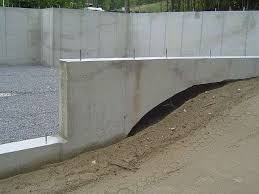Tips on Preventing a Wet Basement and Fixing Basement Water Leaks
By Mark J. Donovan
|
|
Having a basement that is free from water leaks is not a thing of chance. There are a number of steps that you can take to prevent basement water leaks and ensure a dry basement. Some of the steps to preventing basement water leaks should be done during the construction of the home. In other cases, steps can be taken to prevent and fix basement water leaks after the home is built.
Preventing Basement Water Leaks When Constructing a Home One of the best ways to prevent a leaking basement is to install the foundation walls properly so that there is less chance of them cracking and settling. |
Cracked basement walls are often the source of many wet basements. To mitigate the risk of foundation cracks and basement water leaks, proper excavation is essential. All topsoil and clay material should be removed from the foundation site area. Several inches to a foot of large 2 inch diameter, angular gravel should then be placed into the excavated hole and compacted. By taking these steps the concrete footings are ensured to be resting on solid and stable earth. By ensuring a stable footing there is less likelihood that foundation settling will occur, which is often what causes cracked foundation walls.
The second step to take to prevent basement leaks during the construction phase of the home is to seal the exterior basement walls. The basement sealer should be applied from the footing level up to the expected finished grade of the soil.
| Third, when backfilling around the basement foundation walls sandy soil material should be used to allow the surface water to easily drain away from the foundation walls. The backfilling material should also be compacted firmly to remove any air in the soil adjacent to the foundation walls to prevent eventual soil settling and depressions to form.
Finally, when grading the soil around the basement walls the soil should be sloped away from the home. The slope should be at least 1 inch per foot for the first 5 to 10 feet around the perimeter of the foundation walls. |
 |
How to Prevent Basement Water Leaks after the Home is Built
If your home is already built and you are contending with a leaky and wet basement there are a number of things you can do to prevent basement water leaks.
| First and foremost, check to make sure gutter drain spouts are draining rain water away from the home foundation. Also confirm that the finished grade soil slopes away from the home and that there are no low spots or depressions around it. If there are issues with the finished grade soil then have the soil around the home’s foundation re-graded. Typically the finished grade should be sloped at least 1 inch per foot away from the home.
Second, look for hairline cracks in the basement walls and floor. If you observe any, repair them with hydraulic cement. However, before just squeezing some hydraulic cement into the cracks open them up first a bit (approximately ¼ to ½ inch in width) with a hammer and chisel, and remove any loose debris from the cracks with a stiff bristle brush. |
|
Then apply the hydraulic cement to the cracks. Make sure to firmly pack the hydraulic cement into the cracks and to wipe off any excess material using a trowel.
If these issues do not cure your basement water leaks, then you may have no choice but to consider putting in a perimeter drain around the foundation walls. This is an expensive endeavor for preventing basement water leaks, but maybe your only choice. To install a perimeter drain it will require excavating around the foundation wall down to the footing level and then installing the gravel and perforated drain pipes as I described earlier.
For more help on Basement Additions, see HomeAdditionPlus.com’s Basement Remodeling Bid sheet. The Basement Remodeling Bid Sheet will help ensure that your hire the right contractor so that your basement remodeling project is done correctly and you get the project finished on time and budget.
Related Information
- How to Dry a Musty Smelling Basement
- How to Prevent Basement Water Leaks
- How to Maintain a Dry Basement at All Times
Get Free Basement Waterproofing Price Quotes with No Obligation!
Fill out our 3-5 minute quick and easy form, and receive a free price quote on waterproofing from one of our prescreened and licensed waterproofing contractors. This process is free and there is no obligation to continue once you receive your waterproofing price estimate.

